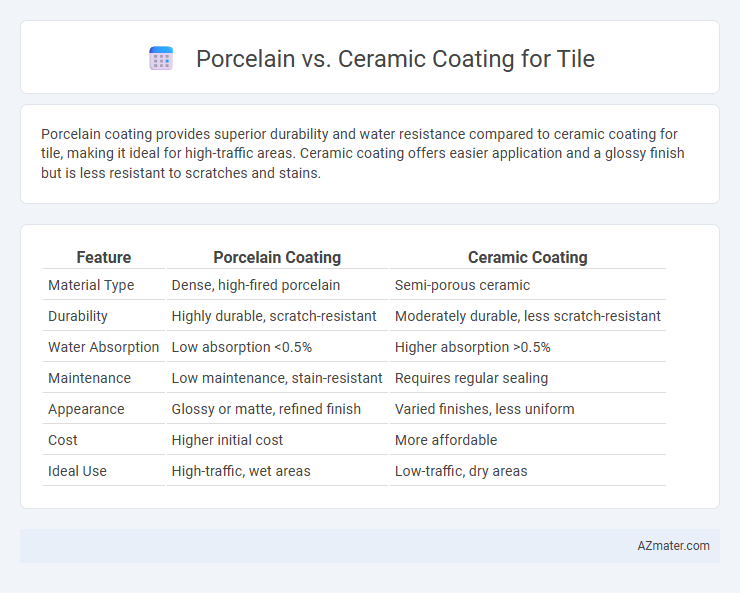Porcelain coating provides superior durability and water resistance compared to ceramic coating for tile, making it ideal for high-traffic areas. Ceramic coating offers easier application and a glossy finish but is less resistant to scratches and stains.
Table of Comparison
| Feature | Porcelain Coating | Ceramic Coating |
|---|---|---|
| Material Type | Dense, high-fired porcelain | Semi-porous ceramic |
| Durability | Highly durable, scratch-resistant | Moderately durable, less scratch-resistant |
| Water Absorption | Low absorption <0.5% | Higher absorption >0.5% |
| Maintenance | Low maintenance, stain-resistant | Requires regular sealing |
| Appearance | Glossy or matte, refined finish | Varied finishes, less uniform |
| Cost | Higher initial cost | More affordable |
| Ideal Use | High-traffic, wet areas | Low-traffic, dry areas |
Introduction to Porcelain and Ceramic Tile Coatings
Porcelain and ceramic tile coatings enhance durability and aesthetic appeal by providing protective layers that resist stains, moisture, and wear. Porcelain tile coatings typically offer higher density and lower porosity compared to ceramic coatings, making them more resistant to water absorption and damage. Specialized sealants for ceramic tiles improve surface hardness and prevent discoloration, extending the lifespan of the flooring in both residential and commercial applications.
Key Differences Between Porcelain and Ceramic Coating
Porcelain coating offers a denser, less porous surface compared to ceramic coating, making it more resistant to stains and moisture infiltration. Ceramic coating typically provides a durable protective layer with enhanced scratch resistance but may require more frequent maintenance due to its slightly higher porosity. The key differences between porcelain and ceramic coatings lie in their composition, durability, and moisture resistance, influencing their suitability for high-traffic or humid areas.
Composition and Manufacturing Processes
Porcelain tiles are made from finer, denser clay mixtures and fired at higher temperatures, resulting in a hard, non-porous surface with better durability and water resistance. Ceramic tiles are composed of coarser clay and other natural materials, fired at lower temperatures, yielding a more porous and softer finish that often requires a glazed coating for protection. The manufacturing process of porcelain involves vitrification, which enhances hardness and reduces water absorption, while ceramic tiles rely more on surface glazes for protection and aesthetic variety.
Durability and Longevity Comparison
Porcelain coatings offer superior durability and longevity compared to ceramic coatings due to their denser composition and higher resistance to scratches, stains, and moisture. Porcelain tiles typically last 50 or more years with minimal maintenance, while ceramic coatings may wear down faster under heavy use, requiring more frequent reapplications to maintain protection. The enhanced hardness and non-porous nature of porcelain make it ideal for high-traffic areas, delivering longer-term performance and reliability.
Aesthetic Appeal and Finish Options
Porcelain coatings for tile provide a smoother, more glass-like finish with a high-gloss aesthetic that enhances color depth and offers superior stain resistance, making surfaces look sleek and vibrant. Ceramic coatings offer a broader range of finish options including matte, satin, and semi-gloss, allowing for more versatile design choices tailored to different styles and textures. Both coatings improve durability, but porcelain's denser composition results in a more refined and polished appearance ideal for modern, high-end applications.
Water Resistance and Stain Protection
Porcelain tile coatings offer superior water resistance due to their dense, non-porous surface, effectively preventing moisture absorption and reducing the risk of water damage. Ceramic tile coatings provide moderate stain protection by forming a protective barrier, though they are more susceptible to water penetration compared to porcelain. Choosing porcelain coatings ensures enhanced durability and long-lasting stain resistance in high-moisture environments.
Maintenance and Cleaning Requirements
Porcelain coatings on tiles provide a denser, non-porous surface that resists staining and requires less frequent cleaning compared to ceramic coatings, which are more porous and prone to absorbing dirt and grime. Cleaning porcelain-coated tiles typically involves simple, regular wiping with mild detergents, whereas ceramic coatings often need more intensive scrubbing and specialized cleaners to maintain their appearance. Maintenance for porcelain-coated tiles is generally lower, making them ideal for high-traffic areas where durability and ease of upkeep are essential.
Cost Analysis: Porcelain vs Ceramic Coating
Porcelain tile coatings generally have a higher upfront cost compared to ceramic coatings due to their enhanced durability and resistance to stains and scratches. Ceramic coatings offer a more budget-friendly option with moderate protection but may require more frequent reapplication, increasing long-term expenses. Evaluating total cost of ownership, including maintenance and longevity, porcelain coatings often deliver better value despite the initial investment.
Best Applications for Each Coating Type
Porcelain coatings are ideal for high-traffic indoor tiles due to their superior durability, resistance to stains, and ability to repel moisture, making them perfect for kitchens and bathrooms. Ceramic coatings work best on outdoor tiles or decorative surfaces, offering excellent UV protection and easy maintenance without compromising the tile's original appearance. Selecting porcelain coating ensures long-lasting performance in demanding environments, whereas ceramic coating optimizes aesthetics and weather resistance in less abrasive settings.
Which Tile Coating is Right for You?
Porcelain and ceramic tile coatings differ primarily in durability and application suitability, with porcelain coatings offering higher resistance to scratches, stains, and moisture due to their denser composition. Ceramic coatings are more affordable and easier to apply, making them ideal for indoor tiles with moderate traffic. Selecting the right tile coating depends on factors like tile material, exposure to harsh conditions, and desired longevity, where porcelain coatings excel in high-traffic or outdoor environments while ceramic coatings suit residential indoor use.

Infographic: Porcelain vs Ceramic coating for Tile
 azmater.com
azmater.com